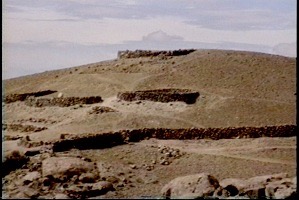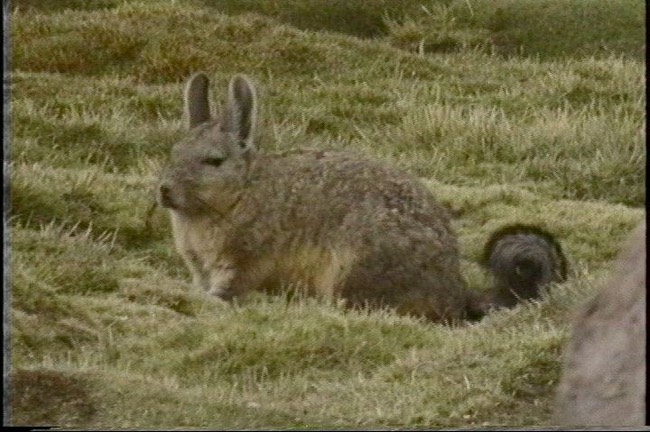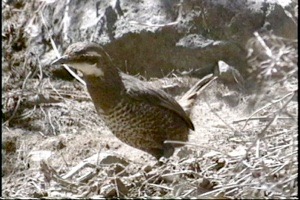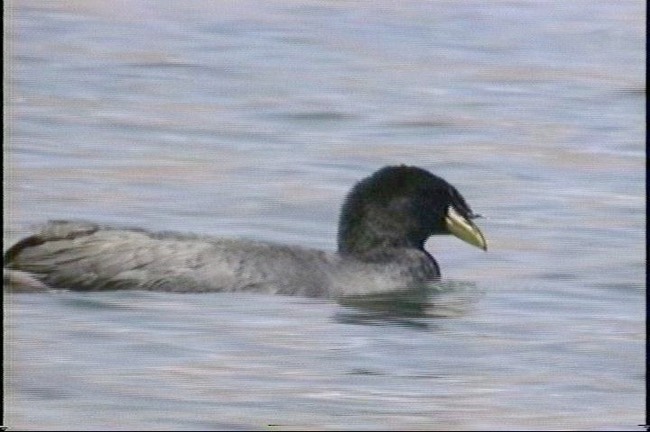I have made only one trip to Chile, three weeks from Santiago to Arica and return. It is a long drive but allowed me to spend time on the coast, in the Atacama Desert, and in the high Andes.
I recorded three long-form videos on this trip. They are embedded below and a species list for each is provided. For videos of individual bird species recorded in Chile see The Birds of Chile video portfolio or access individual clips from the list at the bottom of this page. A photo gallery of The Birds of Chile is also found on this site.
My notes about this trip are found below the videos.
The first two volumes of “Birding Chile - North of Santiago” includes the following species; Chilean Flamingo, Giant Coot, Andean Goose, Black-crowned Night-Heron, Silvery Grebe, Vizcacha (mammal), Puna Tinamou, Speckled Teal, Crested Duck, Common Miner, Andean Gull, Vicuna (mammal), Andean Flicker, Cordilleran Canastero, Puna Teal, White-throated Sierra-Finch, Straight-billed Earthcreeper, Rufous-naped Ground-Tyrant, Wilson’s Phalarope, Ash-breasted Sierra-Finch, Baird’s Sandpiper, Andean Duck, Torrent Duck, Mourning Sierra-Finch, Black-hooded Sierra -Finch, Band-tailed Sierra Finch, Bare-faced Ground-Dove, Hooded Siskin, Greenish Yellow-Finch, Croaking Ground-Dove, Vermillion Flycatcher, Pacific Dove, Cinerous Conebill, Oasis Hummingbird, Surfbird, Blackish Oystercatcher, Ruddy Turnstone, Band-tailed Gull, Franklin’s Gull, Grey Gull, Pectoral Sandpiper, Greater Yellowlegs, American Kestrel, Common Moorhen, Rufous-collared Sparrow, Andean Avocet, Andean Flamingo, Puna Flamingo, Puna Plover, Horned Coot, Ochre-naped Ground-Tyrant, Golden-spotted Ground-Dove, Burrowing Owl, Eared Dove, Chiguanco Thrush, Peruvian Penguin, Peruvian Booby, Peruvian Pelican, Kelp Gull, Chilean Seaside Cinclodes, Red-legged Cormorant, Whimbrel, Turkey Vulture, American Oystercatcher, Black-bellied Plover, Sanderling, Long-tailed Meadowlark, Picui Ground-Dove, Shiny Cowbird, Chilean Mockingbird, Common Diuca-Finch, Giant Hummingbird, Moustached Turca, Plain-mantled Tit-Spinetail, and Grey-hooded Sierra-Finch.
The third volume of “Birding Chile - North of Santiago” includes the following species; Aplomado Falcon, Austral Blackbird, Rufous-collared Sparrow, Chilean Mockingbird, Plumbeous Rail, Eared Dove, Common Diuca-Finch, Great Shrike-Tyrant, Greater Yellowlegs, Chimango Caracara, Common Miner, Long-tailed Meadowlark, Chilean Tinamou, White-throated Tapaculo, Moustached Turca, White-winged Coot, Spot-flanked Gallinule, Great Egret, Southern Lapwing, Kelp Gull, Neotropic Cormorant, Dark-faced Ground-Tyrant, Chilean Seaside Cincloides, House Sparrow, White-crested Elaenia, Picui Ground-Dove, Austral Thrush, Tufted Tit-Tyrant, Cattle Egret, Franklin’s Gull, Black-winged Stilt, Lesser Yellowlegs, Black-necked Swan, Red-gartered Coot, White-tufted Grebe, Red-fronted Coot, Yellow-winged Blackbird, Yellow-billed Pintail, Red Shoveler, Crag Chilia, Dark-bellied Cincloides, Grey-hooded Sierra-Finch, Grey-breasted Seed-Snipe, Rufous-naped Ground-Tyrant, and Black-winged Ground-Dove.
Notes From This Trip
Arica, Chile, just south of the border with Peru, is the City of Eternal Spring. Year-round the daily highs are in the mid-70’s (F) and there is no rain. A beautiful little city of cordial people.
Travel to the highland, from Arica, is on a well maintained but rather scary road. In March of 2006 I heard that a tour bus had run off the road east of Arica near the Bolivian border and a score of people had died. I know that road, I’ve traveled that road a number of times - and I understand the accident. All accidents are bad but I suspect this one was very bad - because the people would have known that they were going to die for quite a while before it happened (”quite a while” being contextual) - it is a long way down.
The road coming down from Bolivia starts at a pass in the Andes and winds through assorted valleys before coming to the main valley leading to the coast. The road is two-lane and is marked with double yellow lines all the way down, for tens of miles. For most of the time, the barriers on the side of the road are minimal and the drop -- although not shear, is close to it -- is for thousands of feet. Ending at the river at the very bottom of the valley. There is nothing on these slopes to stop a vehicle which goes over the edge. The only thing that would stop you is the bottom of the canyon.

It is an incredibly beautiful area, that’s why the tour bus was there no doubt, but it is a place where you must be attentive; there are lots of visual distractions, there is beauty and monotony, there is other traffic and there are lots of big trucks to get stuck behind or to run into. The birding here is exquisite. But at this moment, I extend my best wishes to those left behind and mourn for the terror those who died must have felt.
The birding in this area is fantastic. It is possible to find Puna Flamingos, Andean Flamingos, and Chilean Flamingos in one lake, for example. I was there in February just a few kilometers from Bolivia, in the high Andes.
The air is thin above 10,000 feet and that was, undoubtedly, the reason for my ecstasy. I’m sure it was not because of the sheer raw beauty of the place.
Along the road there were numerous shallow lakes filled with birds; flamingos were filter feeding; coots, ducks, and grebes (all with names not found in North American guide books) floated about; and llamas grazed nearby (all with little colored ribbons in their ears -- these were domestic herds owned by various people in the small mountain villages). The area is flat to rolling with a number of mountain peaks; there were frequent thunderstorms so heed the warnings about climbing these mountains at this time of year -- seems that you will be nothing more than a walking lightening rod.
The colors are sombre but saturated; the photography and videography are great; and Rebecca says that the smell of the place is wonderful. I think the smell is fresh, vivid, and clean but know from experience that I don’t smell things the same way she does. I love this place, the look, the feel -- the smell.

Torrent Ducks were in some of the streams. Why are torrent ducks so pretty? The torrent duck of North America (Harlequin Duck) is - in my opinion - the most strikingly marked duck in the world. The torrent duck of South America (Torrent Duck) is also remarkable, but because of the colors rather than the markings.
I saw the bird pictured here in Chile, high in the Andes in a little valley with a stream running down the middle. At some places lower in the valley there were tall cactus widely spaced on the slopes -- here there was little vegetation taller than my knees.
On the slope in front of me there was an Andean Goose which I had been taping; a few feet to my right is where the Puna Tinamous disappeared; and down the stream about twenty feet was a Torrent Duck, a female, a gorgeous female of the same gorgeous colors of this land. She was in and out of the swiftly flowing stream, stopping periodically to air dry and digest, oblivious to me. Just me, the Torrent Duck, and Rebecca the botanist who peeks at every strange bush, breathes heavily, smiles and beams.
It was February, the middle of summer, when I saw the Torrent Duck and it was cold with a stiff breeze. The sun was pleasant in sheltered areas, much like the high arctic, only here it was altitude not latitude that determined the flora and fauna.
The next day we taped Baird’s Sandpiper at a lake just a couple of miles from the Bolivian border. When we returned to the main road we stopped at a turn-out where there were seven Chilean (or maybe Bolivian) women beside the road selling woolens. We stopped and bought sweaters and blankets. Their work was beautiful, I’m not sure they understood Spanish, certainly not my Spanish. We didn’t barter well, they deserved better and we knew it. (As an aside, the sweaters shrank at the first touch of water [great kids clothes] but the throw-blankets are still beautiful and full of memories -- “Remember when we bought sweaters in the Andes near Bolivia...”)
It was a place which we should all experience, it was so different from my typical world, it was so fundamentally the same. What an incredible experience, an experience which by itself -- and in aggregate of all of our visits -- will change that turn-out high in the Andes to be more like my typical world, a terrible tragic irony.
Not that there has not already been a lot of change in this world. At about 9,000 feet (on the road back to Arica) we stopped to walk through some Pre-Columbian ruins. The ruins were chest-high walls - stacked rough rock, not the finely cut stones you see in the Inca (spelled Inka, here) cities. The walls were built in concentric rings, one inside the other on a knoll overlooking a deep valley. This was, and is, a trade-route and this was a fortification.

On the slopes of the valley there were numerous terraces, which are still farmed by the indigenous people of this area. I suspect that the terraces are Pre-Columbian as well, but they are not “tourist sites” - I guess farming just isn’t as exciting as war.
I spent an hour taping a Greenish Yellowfinch there, lots of Finches in the area, lots of species. The Yellowfinch would fly around from one fortification wall to the next with me in tow. Dark rock walls with bright yellow-green birds.
At the height of their power, it is said that the Inca would march up to such places with their army of 100 to 200 thousand troops and say “want to join us or fight us” - in that way they were able to expand their empire, at times, with relatively little bloodshed.

Sometimes the mammals are so exotic that they steal the show from the birds. Such a creature is the Vizcacha which we found in the Chilean Andes. Strange creatures to my view - there are similarities to North American species; rabbits and squirrels primarily - to me it is odd, this amalgamation of species I know from elsewhere. Here, it is the way things are.
The Vizcachas ignored us, we couldn’t ignore them, allowing for some great video. After we taped the Vizcacha we crossed the road and found a Vicuna, this was not a domesticated animal like the Llama herds which dot the plains, it was a lone animal which watched us carefully while pretending to ignore. Off to the side, on what looks like ocotillo (but are not, trying to force fit to reference points often leads to mistakes - thus the problem with stereotypes) sat a singing Mourning-Finch, species undetermined at that distance.
In northern Chile it is very dry (as in Atacama Desert dry) and except for the high Andes the water is restricted to the rivers flowing down the mountains to the sea. In these river valleys there is always a ribbon of green (either cultivated or natural) along the river. Aqueducts built by Pre-Columbians are still used to move the precious water around and it is in such valleys - and using similar water distribution systems - that many of the major cultures of Peru and the rest of the South American west coast developed.
From Arica, the Azapa Valley runs up the river toward the Andes. There are many little farms along the river and there are many stops for birds -- lots of Ground-Doves, and species of Ground-Doves, in this area.
There are lots of places to stop and explore, at one site I was trying to video a Cinerous Conebill and having some trouble with the exposure levels, it was very bright and the bird would not stay in one spot or in the shade. A pickup stopped to see the foreigners and we and the locals talked about the beauty of this area, about water, and about rain. There was a lot of laughing as they try to fathom a place where we sometimes feels that it rains all the time - my home at that time, in Oregon - and I try to understand a place where it never rains (like my home in 2018).

Near Olmue, Chile, Rebecca and I spent a morning in a canyon of the Parque Nacional La Campana taping Moustached Turca (framegrab from the video shown here). Otherwise than the Turca we had no great success and ventured back to the village where a local restaurateur agreed to feed us although it is not quite the right hour.
We ordered Ensalada Chilena with our meal and were very pleased when it came, diced tomatoes (fresh and tasty) and sweet onions, salted, with olive oil. A great combination which I still make at home.
In March we were in San Alfonso, Chile using a very pleasant inn as our base for operations near Embalse El Yeso which is much higher. One evening we have ordered Pastel de Choclo, another Chilean speciality. We enjoyed it immensely and our host asked if we would like the left overs tomorrow -- we would -- and they go off to the frig to await our return from the high mountains in the p.m. of tomorrow.
Putre is a classic Indian village high in the Andes of northeastern Chile. It is small, there are no two-story buildings, everything is carved stone - the houses, the roads, everything. There are no signs to speak of but we found one which seemed to indicate that a restaurant was through the open door. We ventured in and sat at the one rickety table on rickety chairs on a clay floor. A long morning of Torrent Ducks and Sierra-Finches (like the Band-tailed Sierra Finch to the right) had made us very hungry. We waited in anxious anticipation.
An older man came in from the kitchen and lit a candle for us, the only other light was that which came from the open door. After a bit we conclude that he understood we want to eat but don’t have a clue what. There are no menus of course and our lack of Spanish was not helpful.
After a while he brought some crusty home made bread and some dark home made wine (from what?). We broke bread (literally) and tried some wine. Both were good, perhaps more interesting than good. Then he brought out huge bowls of stew and a two old spoons - napkins?, that is what jeans are for -- He poured himself a glass of wine we toasted each other, then he ventured back to the kitchen.
His young grandson peeked into the room as we ate.
The stew was a Chilean speciality (Cazuela de Vaca), and I dare say authentic. Tubers of various types make up the dish, which is very tasty. Amazingly the crusty bread and wine are the perfect compliment to the stew. It is delicious and as I ate, I reflected that I would probably never have it again.
The Aplomodo Falcon is an exotic (as in rare) bird in the Southwest of the United States, and in Texas which is also in the United States. Seeing one in the US is an exciting event. But in central Chile I recorded one in a more casual setting, I was swimming back and forth in a very warm pool, trying to melt the fatigue away - but I was having problems, every once in a while I had to get out and video tape the Aplomado Falcon perching beside the pool. All afternoon. It was supposed to be a rest day - darn Aplomodo Falcon.
Farther south I had a much more depressing experience. We were taping at the mouth of the Rio Aconcagua on the central coast. The farm yards are full of gulls and Chimango Caracara - also assorted shorebirds. The lighting has been poor but the access here was along some railroad tracks and they made a nice platform to tape from. All of this was nice, it was not why I was depressed.
I was depressed because a local had just talked to me about doing something about the refinery blight across the river. Since I had a camera I must be in a position to do something about crimes against the Earth. Across the river there was an oil refinery, everything near it is blighted, full of oil sludge, poisoned, etc. etc. - the list goes on and on. It is a terrible sight, it is a terrible thought that people would do this for no other reason than money, for simple greed. I was depressed, I am depressed because of what is happening and I am depressed because I doubt that I will ever be able to do anything about this rape of the planet.
We had a bird finding guide with us as we traveled about. The birding guide book said that we should park on the north side of the bridge. The ravine was a hundred or so feet deep but the sides were not terribly steep. Rebecca and I traversed back and forth, working our way down the slope, finally finding a semi-level spot for the tripod. Out came the binoculars, Long-tailed Meadowlark over there, assorted Sierra-Finches down the slope, a Mustached Turca scratching in the soil on the other side and there! There it was, a Giant Hummingbird -- sure enough the wing beats seem painfully slow for a hummingbird, like real life in slow motion cinema. As cooperative as the bird was, it refuseed to come to our side and we couldn't get closer. We filmed in the hot sun all afternoon, no shade here in northern Chile.
Not far from that ravine, Rebecca and I spent some time on the coast north of Chanaral. It was dry but not nearly as arid as the Atacama Desert through which we have traveled as we headed south (that is an incredible place - a place where there is no vegetation - none).
Parque Nacional Pan De Azucar (Sugarloaf) is just north of town and turned out to be a great place for all sorts of shorebirds and great close-ups of Turkey Vultures. We were here to boat out to the Isla Pan de Azucar which has the largest colony of Humboldt (Peruvian) Penguins in Chile (photo right).
There were a couple of shacks on the beach and no other sign of human existence. At one of the stands we arranged for a boat to the island (they took pains to assure that we understood that we could not actually get onto the island because it is a refuge).
We taped in the vicinity, waiting for the boat to get ready. Getting ready in this instance meant swimming out to a moored boat, climbing aboard, starting the engine, and heading to shore. About twenty feet out the boat stoped and waited for a wave cycle. (The waves break right on the beach and have a very short beach run, meaning that it is deep right at the beach’s edge.) In the mean time, those of us who were going out to the island walked down to the beach and waited by the surf. The boat engine was suddenly gunned and the boat rode in on the crest of a wave. The boat ground into the sand and we all dashed for the boat, clambered over the side. The result was a mass of equipment and people in the bottom of the boat, but we made it before the next wave. The next wave came in, lifted the boat slightly and the "shore crew" pushed the boat out as quickly as possible. The boat turned, the engine was gunned, and we crash through the next wave on our way to the island which is only four kilometers from shore.
On our way to some of the lakes of the high Andes we stop at a customs station well within Chile. We queue up with the truck drivers, not sure what the routine is, an offficial glances at us every once in a while and goes about his business. After about ten minutes he waves us to the front of the line, we clearly do not know what is going on, we show him a map pointing to the lakes of Miscanti and Miniques (both on this side of the border) he looks up -- “go on”, he says in the international language of hand waving “you don’t need to do anything here”.
Off we go, traveling along the dusty but pretty well maintained road until we come to a track which leads to the left and from the map we conclude this must be the place. After bumping around for awhile and hoping that I don’t have to back down this thing we crest the hill and see one of the lakes. Very pretty setting, even at the height of summer it is chilly and there is a dusting of snow on the hills which surround the lake.

There are many species of coot (including the Giant Coot pictured here) and grebe in Chile and the high Andes has its share. I spend a lot of time taping coots and ground-tyrants.
After a couple of hours, a jeep drives up and two people get out, a brother and sister it turns out. He is a Civil Engineer up from Antofagasta to see his sister, a tour guide, who works in San Pedro de Atacama. We chat for quite awhile. The informal meetings which happen in my travels, informal meetings in exotic locales, add a special dimension to these trips which is hard to explain but a joy to experience.
When we were just entering Chile, a Customs agent pulled us aside and told us that we would have to pay a tariff, something like $40 USD as I recall. Okay, we pay the tariff. The Customs Agent is adamant however:
“Do you know why you are paying the tariff?”
“Because you said to.”
“No, it is because your government charges a fee like this when we visit America.”
“Oh.”
“If you don’t like it, tell your government.”
“Okay.”
“Forty dollars please.”
Reciprocal arrangements are typical when you travel, the last time I went to Brazil, for instance, I had to have my photograph taken and I was fingerprinted. -- On the other hand, I got to stand in a special line for US Citizens.
LISTING OF VIDEO CLIPS OF INDIVIDUAL SPECIES RECORDED IN CHILE